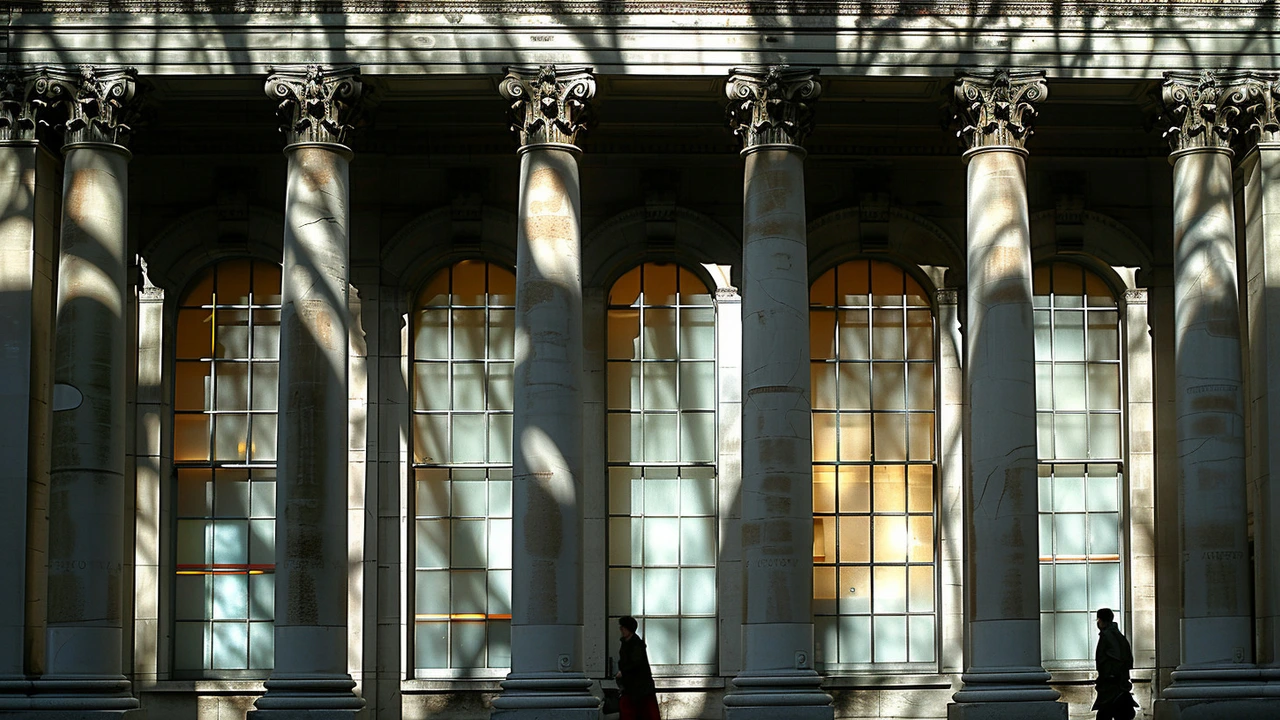Bank of England Maintains 5.25% Interest Rate Ahead of Critical Election
The Bank of England has decided to hold its main interest rate at a 16-year high of 5.25%, amidst a backdrop of political uncertainty as the UK approaches its July 4 election. This decision by the monetary policy committee (MPC) was reached through a 7-2 vote, aligning with the expectations of leading economists. Despite recent data indicating that inflation has finally reached the central bank's target of 2%, Governor Andrew Bailey emphasized the necessity for more consistent evidence before considering a rate cut.
Historically, the Bank of England's approach to managing interest rates has been closely linked to the country's inflation levels. While the 2% target was viewed as a significant benchmark, Bailey's cautious stance underscores the importance of ensuring long-term price stability. His current caution contrasts with his earlier statements, which suggested a more optimistic view on the possibility of a rate cut. It appears that the underlying inflationary pressures, particularly from the services sector and the accelerated wage growth, have warranted a more circumspect approach.
Economic Indicators and Market Reactions
High services sector inflation and rapid wage growth continue to exert pressure on the Bank of England's policy decisions. These sectors play a crucial role in the overall economy, and inflation here can often indicate broader economic trends. The MPC's decision not to adjust rates has significant implications for various stakeholders, from local businesses to international investors.
Markets have been swift to interpret the bank's actions, with predictions now indicating an 88% probability of a quarter-point rate cut by September. This forecast suggests that market participants believe the central bank's current position might be a temporary measure, possibly influenced by the upcoming election and current economic data. However, it also reflects cautious optimism that the economy will stabilize sufficiently to allow for a more accommodative monetary policy.
Comparison with Global Central Banks
Interestingly, the Bank of England's decision occurs in stark contrast to the recent moves by other major central banks. For example, the European Central Bank has already implemented a rate cut, seeking to invigorate their economy. Conversely, the US Federal Reserve has indicated that it is unlikely to reduce borrowing costs until later this year. This global context is vital for understanding the broader economic landscape and helps highlight the uniqueness of the UK's economic position.
Political and Public Sentiment
Prime Minister Rishi Sunak's Conservative Party appears to be under significant pressure, with recent polls placing them 20 points behind the opposition Labour Party. This political rift is exacerbated by economic conditions, particularly high mortgage rates, which Labour attributes to economic mismanagement by the former Conservative leader, Liz Truss. As the election day approaches, economic policies and their direct impact on everyday life will be in sharp focus, influencing public opinion and voting behavior.
The intersection of economic policy and political strategy is complex. For the Conservative Party, maintaining a stable economic environment might bolster their position, whereas any signs of financial instability could further erode public confidence. On the other side, Labour's narrative around high mortgage rates as a symptom of Conservative governance adds another layer of pressure on the Bank of England to demonstrate prudence in their policy alignments.

Looking Forward
As we edge closer to the election, the Bank of England's decisions will be scrutinized with even greater intensity. The current holding pattern on interest rates represents a balance between encouraging economic stability and awaiting more definitive signs of long-term inflation control. While the data points to a positive trend with inflation hitting the 2% target, the underlying economic factors carry weight in determining future policy directions.
Should the anticipated rate cut by September materialize, it may signal a cautious optimism regarding economic recovery and stabilization. However, this is contingent on various factors, including wage growth trends, sector-specific inflation rates, and broader economic indicators. Continuous monitoring and adaptive policy responses will be essential in navigating these complexities.
For now, the Bank of England's stance reflects a nuanced understanding of the current economic landscape, balancing immediate data-driven insights with a foresighted approach to policy-making. As voters head to the polls, these economic considerations will undoubtedly play a significant role in shaping the country's future direction.






7 Comments
Saurabh Singh
June 21, 2024 AT 15:57 PM5.25%? That’s a death sentence for small businesses and first-time buyers. You call this 'prudence'? It’s just political cowardice dressed up as economic theory. The Bank’s playing it safe while real people drown in mortgage payments. And don’t even get me started on how they ignore wage growth as a *driver*, not a symptom. This isn’t policy-it’s a performance for the Tories.
Meanwhile, the ECB’s cutting rates and the Fed’s waiting? We’re the odd ones out because we’re too scared to admit we messed up. Wake up, Bailey. The market’s already priced in the cut. You’re just delaying the inevitable while pretending you’re in control.
Mali Currington
June 22, 2024 AT 07:05 AMSo the Bank finally hit 2% inflation... and they’re still holding rates like it’s 2008? Brilliant. Truly. Who needs a functioning economy when you’ve got a 16-year high to show off to your grandchildren?
INDRA MUMBA
June 24, 2024 AT 05:55 AMLet’s unpack this with some nuance-because the media’s reducing this to a political ping-pong match, and that’s doing everyone a disservice. The Bank’s stance isn’t just about inflation numbers; it’s about *persistence*. Services inflation is still running at 4.8%, wage growth is hovering near 5%, and household balance sheets are fraying under the weight of fixed-rate mortgages that reset in 2025. This isn’t stubbornness-it’s damage control. The MPC knows that a premature cut could reignite embedded inflation, especially if union negotiations kick off post-election. They’re not being lazy; they’re being *architects* of a fragile equilibrium. And yes, the ECB’s move is different because the Eurozone’s labor market isn’t as tight, and Germany’s industrial base is still contracting. We’re not in their shoes. We’re in the eye of the storm, and Bailey’s holding the umbrella while everyone else is dancing in the rain.
Also, let’s not forget: the Bank’s mandate is price stability, not electoral popularity. If Labour wins and immediately pushes for a rate cut to 'help households', they’re going to inherit a house of cards. The real villain here isn’t the Bank-it’s the decade of underinvestment in productivity, housing, and skills that got us here.
Anand Bhardwaj
June 24, 2024 AT 07:13 AMHonestly? I just want to know if my rent’s going to drop before I get evicted. The Bank’s got charts, economists, and fancy acronyms-but I just need to know if I can afford to keep my lights on. Meanwhile, everyone’s debating whether Bailey’s a hero or a villain, and I’m just trying to figure out if I should sell my car or move back in with my mum.
RAJIV PATHAK
June 26, 2024 AT 01:59 AMAh yes, the Bank of England-where the only thing more impressive than their interest rate decisions is their ability to produce 12-page press releases that say absolutely nothing. 5.25%? How quaint. In my day, we called that 'economic theater'-a ritual performed by bureaucrats who’ve never actually had to pay a mortgage. The fact that they’re still using 'services inflation' as a justification is almost poetic. It’s like blaming the weather for your bad haircut. The real issue? The entire UK economy is now a derivatives trading desk with a population problem.
Nalini Singh
June 26, 2024 AT 07:34 AMThe Bank of England’s decision must be viewed through the lens of institutional credibility and long-term macroeconomic stewardship. While short-term political pressures may urge expediency, the central bank’s mandate is not to serve electoral cycles but to preserve the integrity of the currency. The persistence of wage-price spirals, particularly in the services sector, remains a systemic risk that cannot be mitigated by hasty monetary easing. The European Central Bank’s actions, while commendable in their own context, reflect structural differences in labor mobility, fiscal federalism, and energy dependency that do not obtain in the United Kingdom. To conflate these contexts is to engage in economic reductionism. We must, therefore, respect the Bank’s deliberative caution as an act of institutional responsibility-not political timidity.
Sonia Renthlei
June 26, 2024 AT 12:51 PMI just want to say how deeply I feel for all the people who are struggling right now-especially single parents, elderly folks on fixed incomes, and young people trying to buy their first home. I know the Bank’s job is to manage inflation, but I also know that behind every number is someone who’s choosing between medicine and groceries, or skipping a meal so their kid can have a new pair of shoes. I’ve talked to so many people in my community who say they’re scared to even think about moving or changing jobs because of these rates. And honestly? It breaks my heart. I wish there was more of a human layer to these decisions. Maybe the Bank should sit down with actual families-not just economists and bankers-and hear what it really feels like to live under 5.25%. Because inflation might be at 2%, but the cost of dignity? That’s still skyrocketing.
And I get that the Bank has to be cautious-wage growth is real, services are hot, and we don’t want to go back to the 70s-but what if they started thinking of this as a social problem, not just a financial one? What if they partnered with housing charities, local councils, and unions to design a transition plan? Maybe the cut isn’t just about interest rates-it’s about rebuilding trust. And trust? It doesn’t come from charts. It comes from listening.